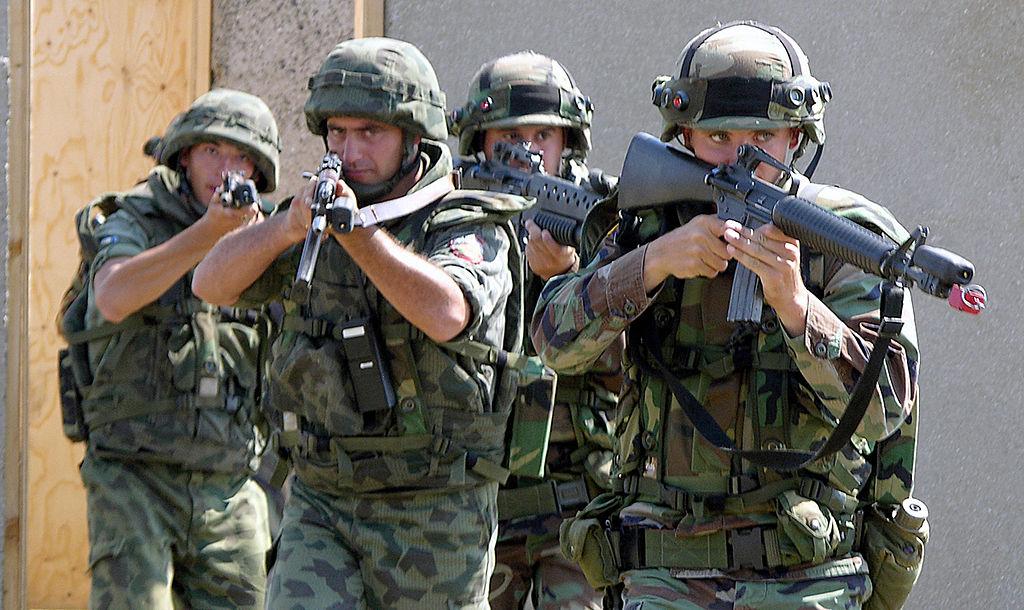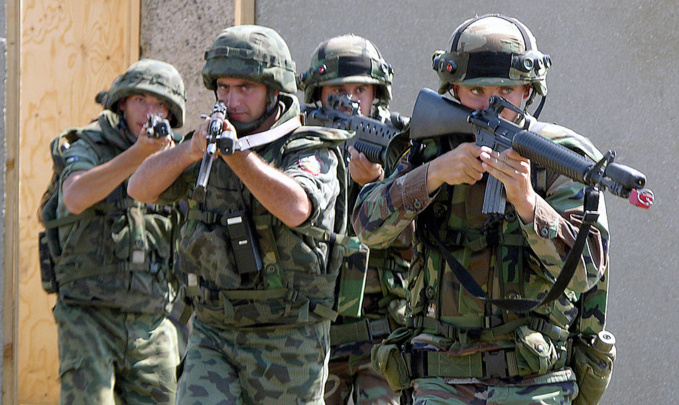A much-needed modernization program
Bulgaria has drawn the potential of its military equipment down to the last drop and can no longer delay upgrading operations if it wishes to maintain its operational readiness and its ability to defend itself. Ever since the end of the cold war, Sofia has largely relied on the Soviet-based military equipment it inherited.
Though large in numbers - Bulgaria had thousands of tanks, armored personnel carriers and howitzers in 1990 - their condition decreased steadily. This led to the drastic reduction of actually available numbers, making the large fleet in fact very weak. Moreover, the economic crisis which hit all countries in the former Eastern bloc prevented the reform of military forces for nearly 20 years.
However, Bulgaria has re-launched its economy and is currently carrying out the reform its armed forces needed for a long time. As reported by defense specialist Jakub Palowski, “According to the assumptions of the aforementioned document, adopted and approved by the Bulgarian Council of Ministers, level of the GDP contribution of the defence expenditure is going to be maintained, and its value is going to be equal to the one present during the year 2014 (ca. 1.3% of the GDP). The situation is going to be virtually the same, until 2018. However, until 2024, the above-mentioned level is going to be gradually increased, should “beneficial conditions” occur.”
The first department to receive its new equipment was the Air Force, with initial talks in 2019 to purchase an entire fleet of modernized F-16 fighter planes, for 1.5 billion dollars. These fighters would come to replace the aging fleet of Mig-29 Fulcrums and mark the historical shift from Soviet-based equipment to US-based technology. Land forces are also awaiting modernization, with the tender for new Infantry Fighting Vehicles to replace the fleet of BMP armored cars which has aged past the point of disrepair.
Strange aspects in the tender for IFVs
The official document, which was released to the manufacturers, asking them to make their offers, has sparked interest and concern in the press, and in the ranks. The conditions which have been applied to the deal suggest both that defense minister Krasimir Karakachanov has little experience in such matters, and that the tender is in fact a ploy and that the ultimate winner of the competition has already been chosen. Defense specialist Assen Georgiev writes : “The Land Forces redevelopment project is the second major modernization project to be completed in recent years following the already signed F-16 deal. A number of government officials have confirmed in recent years what the military has been alarming about for a long time - that the state of the art of infantry is critical and is not delayed. That is why it is of particular importance now that the rearmament project is no longer delayed but rather completed soon with a bargain on quality modern weapons, which will finally allow the army to carry out its duties under normal conditions. The budget allocated for the infantry is BGN 1.464 billion with VAT, and it is planned to be used for 150 new armored vehicles - 90 of which are combat and 60 auxiliary.” The journalist points out to many technical and financial parameters in the document which either make no sense, or place Bulgaria at a disadvantage.
Chasing several goals and missing all?
Is Bulgaria trying to get the best equipment possible, strengthen its alliances, favor its own economy, and save money, all at once? If so, Krasimir Karakachanov needs to reconsider his strategy with his counselors. Bulgaria can indeed purchase Piranha V vehicles to tighten ties with the Americans, but that means renouncing the idea of buying top grade equipment - the Piranha V has never tried in battle and its predecessor, the Piranha III, has a disastrous track record. It can go cheap with the Finnish Patria offer, but this means building its own vehicles, under license agreement, and bearing the entire industrial risk. Is Bulgaria trying to keep long-term control of its military budgets? If so, the Piranha V offer will not do: General Dynamic Land Systems (GDLS) is known to low-ball competition, and then cash in on maintenance contracts. Turning to the Americans is an option, in order to consolidate its NATO membership which, until now, hadn’t amounted to much. But the timing is perhaps poor, now that many European countries are turning away from NATO. While the end game remains yet unclear, it seems quite likely that the next strategy, whatever it will be, will rely on a fully operational and functional army.
The Bulgarian modernization program illustrates the high number of parameters which must be taken into account in defense strategies, and mostly that all factors, even if they are known, amount to little if they are not rationalized and managed by a unified command. Such a strategic vision seems to be lacking, so far, in Sofia, leading to power instinctively leaning towards the American center of gravity. As military equipment tenders hit the rocks, Bulgaria may start feeling the need to plan its modernization more strategically.
Bulgaria has drawn the potential of its military equipment down to the last drop and can no longer delay upgrading operations if it wishes to maintain its operational readiness and its ability to defend itself. Ever since the end of the cold war, Sofia has largely relied on the Soviet-based military equipment it inherited.
Though large in numbers - Bulgaria had thousands of tanks, armored personnel carriers and howitzers in 1990 - their condition decreased steadily. This led to the drastic reduction of actually available numbers, making the large fleet in fact very weak. Moreover, the economic crisis which hit all countries in the former Eastern bloc prevented the reform of military forces for nearly 20 years.
However, Bulgaria has re-launched its economy and is currently carrying out the reform its armed forces needed for a long time. As reported by defense specialist Jakub Palowski, “According to the assumptions of the aforementioned document, adopted and approved by the Bulgarian Council of Ministers, level of the GDP contribution of the defence expenditure is going to be maintained, and its value is going to be equal to the one present during the year 2014 (ca. 1.3% of the GDP). The situation is going to be virtually the same, until 2018. However, until 2024, the above-mentioned level is going to be gradually increased, should “beneficial conditions” occur.”
The first department to receive its new equipment was the Air Force, with initial talks in 2019 to purchase an entire fleet of modernized F-16 fighter planes, for 1.5 billion dollars. These fighters would come to replace the aging fleet of Mig-29 Fulcrums and mark the historical shift from Soviet-based equipment to US-based technology. Land forces are also awaiting modernization, with the tender for new Infantry Fighting Vehicles to replace the fleet of BMP armored cars which has aged past the point of disrepair.
Strange aspects in the tender for IFVs
The official document, which was released to the manufacturers, asking them to make their offers, has sparked interest and concern in the press, and in the ranks. The conditions which have been applied to the deal suggest both that defense minister Krasimir Karakachanov has little experience in such matters, and that the tender is in fact a ploy and that the ultimate winner of the competition has already been chosen. Defense specialist Assen Georgiev writes : “The Land Forces redevelopment project is the second major modernization project to be completed in recent years following the already signed F-16 deal. A number of government officials have confirmed in recent years what the military has been alarming about for a long time - that the state of the art of infantry is critical and is not delayed. That is why it is of particular importance now that the rearmament project is no longer delayed but rather completed soon with a bargain on quality modern weapons, which will finally allow the army to carry out its duties under normal conditions. The budget allocated for the infantry is BGN 1.464 billion with VAT, and it is planned to be used for 150 new armored vehicles - 90 of which are combat and 60 auxiliary.” The journalist points out to many technical and financial parameters in the document which either make no sense, or place Bulgaria at a disadvantage.
Chasing several goals and missing all?
Is Bulgaria trying to get the best equipment possible, strengthen its alliances, favor its own economy, and save money, all at once? If so, Krasimir Karakachanov needs to reconsider his strategy with his counselors. Bulgaria can indeed purchase Piranha V vehicles to tighten ties with the Americans, but that means renouncing the idea of buying top grade equipment - the Piranha V has never tried in battle and its predecessor, the Piranha III, has a disastrous track record. It can go cheap with the Finnish Patria offer, but this means building its own vehicles, under license agreement, and bearing the entire industrial risk. Is Bulgaria trying to keep long-term control of its military budgets? If so, the Piranha V offer will not do: General Dynamic Land Systems (GDLS) is known to low-ball competition, and then cash in on maintenance contracts. Turning to the Americans is an option, in order to consolidate its NATO membership which, until now, hadn’t amounted to much. But the timing is perhaps poor, now that many European countries are turning away from NATO. While the end game remains yet unclear, it seems quite likely that the next strategy, whatever it will be, will rely on a fully operational and functional army.
The Bulgarian modernization program illustrates the high number of parameters which must be taken into account in defense strategies, and mostly that all factors, even if they are known, amount to little if they are not rationalized and managed by a unified command. Such a strategic vision seems to be lacking, so far, in Sofia, leading to power instinctively leaning towards the American center of gravity. As military equipment tenders hit the rocks, Bulgaria may start feeling the need to plan its modernization more strategically.



















